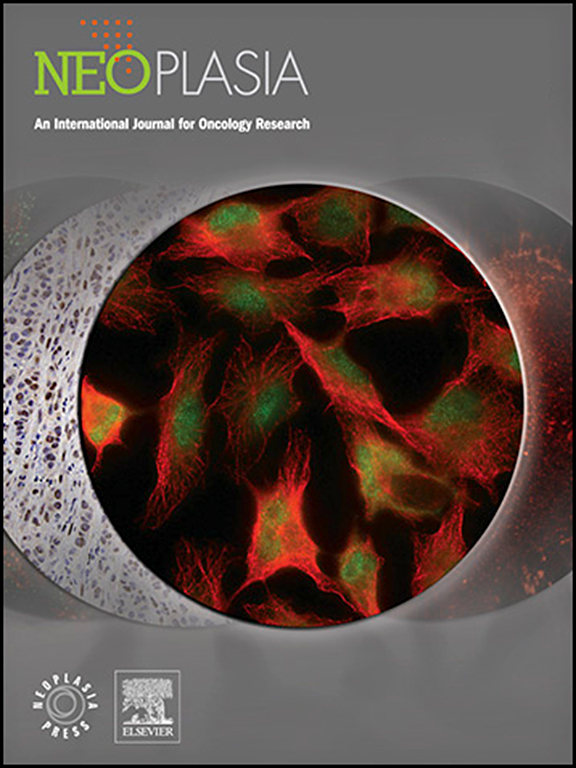Disitamab vedotin combined with toripalimab and radiotherapy for multimodal organ-sparing treatment of muscle invasive bladder cancer: a proof-of-concept study
IF 7.7
2区 医学
Q1 Biochemistry, Genetics and Molecular Biology
引用次数: 0
Abstract
Purpose
Although trimodal therapy is currently the standard organ-sparing approach for muscle-invasive bladder cancer (MIBC), its clinical benefit is limited, and noninvasive biomarkers to guide dynamic decision-making are lacking. Here, we present a proof-of-concept study evaluating disitamab vedotin (RC48, a HER2-targeted antibody-drug conjugate) combined with toripalimab (JS001, anti-PD-1) and radiotherapy for bladder preservation in localized HER2-positive MIBC.
Patients and Methods
In the first-stage of an open-label phase II clinical trial (ClinicalTrials.gov identifier: NCT05979740), six patients were enrolled and received disitamab vedotin, toripalimab, and radiotherapy. Adverse events were documented according to the National Cancer Institute Common Terminology Criteria for Adverse Events (CTCAE v5.0). Tumor response was evaluated every 12 weeks by radiographic imaging, cystoscopy with biopsies, and urine cytology. In parallel, we performed longitudinal liquid biopsy analyses of circulating tumor DNA (ctDNA) and urinary tumor DNA (utDNA) using PredicineCARE assay.
Results
The combination was overall tolerable, with no grade 4 treatment-related adverse events or deaths. Five patients (83.3 %) achieved a complete response and remained recurrence-free. Notably, utDNA testing showed high accuracy in monitoring therapeutic effectiveness and enabled early detection of tumor relapse, whereas ctDNA was largely undetectable across blood samples.
Conclusions
These findings establish the feasibility, efficacy, and potential biomarker utility of a novel bladder-preserving regimen, setting the stage for a paradigm shift in MIBC management.
双西他单维多汀联合多利帕利单抗和放疗用于多模式器官保留治疗肌肉浸润性膀胱癌:一项概念验证研究
目的:虽然三模式治疗是目前肌肉浸润性膀胱癌(MIBC)的标准器官保留方法,但其临床益处有限,且缺乏指导动态决策的非侵入性生物标志物。在这里,我们提出了一项概念验证研究,评估了双西他马维多汀(RC48,一种her2靶向抗体-药物偶联物)联合托利单抗(JS001,抗pd -1)和放疗对局部her2阳性MIBC的膀胱保护作用。在一项开放标签II期临床试验(ClinicalTrials.gov识别号:NCT05979740)的第一阶段,6名患者入组,接受了迪西他单维多汀、托利莫单抗和放疗。不良事件按照美国国家癌症研究所不良事件通用术语标准(CTCAE v5.0)进行记录。每12周通过x线影像、膀胱镜活检和尿液细胞学评估肿瘤反应。同时,我们使用PredicineCARE法对循环肿瘤DNA (ctDNA)和泌尿肿瘤DNA (utDNA)进行纵向液体活检分析。结果联合治疗总体耐受,无4级治疗相关不良事件或死亡。5名患者(83.3%)获得完全缓解,并保持无复发。值得注意的是,utDNA检测在监测治疗效果和早期发现肿瘤复发方面显示出很高的准确性,而ctDNA在血液样本中基本上检测不到。这些发现确立了一种新的膀胱保留方案的可行性、有效性和潜在的生物标志物实用性,为MIBC管理的范式转变奠定了基础。
本文章由计算机程序翻译,如有差异,请以英文原文为准。
求助全文
约1分钟内获得全文
求助全文
来源期刊

Neoplasia
医学-肿瘤学
CiteScore
9.20
自引率
2.10%
发文量
82
审稿时长
26 days
期刊介绍:
Neoplasia publishes the results of novel investigations in all areas of oncology research. The title Neoplasia was chosen to convey the journal’s breadth, which encompasses the traditional disciplines of cancer research as well as emerging fields and interdisciplinary investigations. Neoplasia is interested in studies describing new molecular and genetic findings relating to the neoplastic phenotype and in laboratory and clinical studies demonstrating creative applications of advances in the basic sciences to risk assessment, prognostic indications, detection, diagnosis, and treatment. In addition to regular Research Reports, Neoplasia also publishes Reviews and Meeting Reports. Neoplasia is committed to ensuring a thorough, fair, and rapid review and publication schedule to further its mission of serving both the scientific and clinical communities by disseminating important data and ideas in cancer research.
 求助内容:
求助内容: 应助结果提醒方式:
应助结果提醒方式:


